HRMM055 - Attitudes and Job Satisfaction: A Report on Motivation
VerifiedAdded on 2023/04/19
|14
|3554
|388
Report
AI Summary
This report delves into the crucial role of attitudes and job satisfaction in motivating employees within an organization. It defines attitudes as evaluative statements about people, objects, and events, highlighting their cognitive, affective, and behavioral components. The report also examines job satisfaction as a key driver of employee self-motivation, fostering job stability, work-life balance, and career growth. It further explores factors influencing employee motivation, including salary, non-monetary incentives, relationships with co-workers and leaders, and company culture. Motivational theories, such as Maslow's hierarchy of needs and Herzberg's hygiene theory, are discussed in relation to job satisfaction. The report concludes by emphasizing the importance of strategies to enhance employee motivation for organizational success, particularly in competitive environments, with Desklib offering additional resources for students.

Running head: ATTITUDES AND JOB SATISFACTION
ATTITUDES AND JOB SATISFACTION
Name of the student:
Name of the university:
Author Note:
ATTITUDES AND JOB SATISFACTION
Name of the student:
Name of the university:
Author Note:
Paraphrase This Document
Need a fresh take? Get an instant paraphrase of this document with our AI Paraphraser
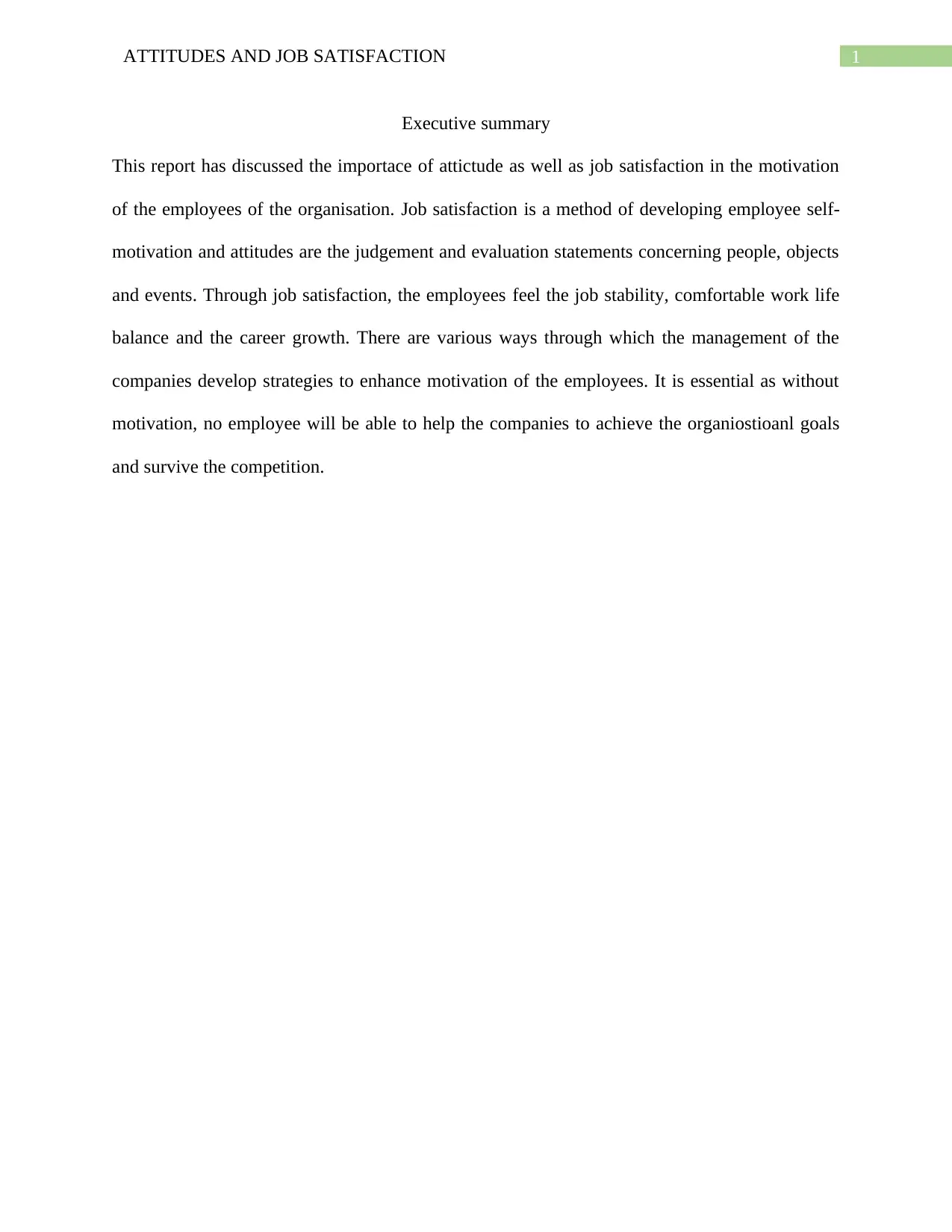
1ATTITUDES AND JOB SATISFACTION
Executive summary
This report has discussed the importace of attictude as well as job satisfaction in the motivation
of the employees of the organisation. Job satisfaction is a method of developing employee self-
motivation and attitudes are the judgement and evaluation statements concerning people, objects
and events. Through job satisfaction, the employees feel the job stability, comfortable work life
balance and the career growth. There are various ways through which the management of the
companies develop strategies to enhance motivation of the employees. It is essential as without
motivation, no employee will be able to help the companies to achieve the organiostioanl goals
and survive the competition.
Executive summary
This report has discussed the importace of attictude as well as job satisfaction in the motivation
of the employees of the organisation. Job satisfaction is a method of developing employee self-
motivation and attitudes are the judgement and evaluation statements concerning people, objects
and events. Through job satisfaction, the employees feel the job stability, comfortable work life
balance and the career growth. There are various ways through which the management of the
companies develop strategies to enhance motivation of the employees. It is essential as without
motivation, no employee will be able to help the companies to achieve the organiostioanl goals
and survive the competition.
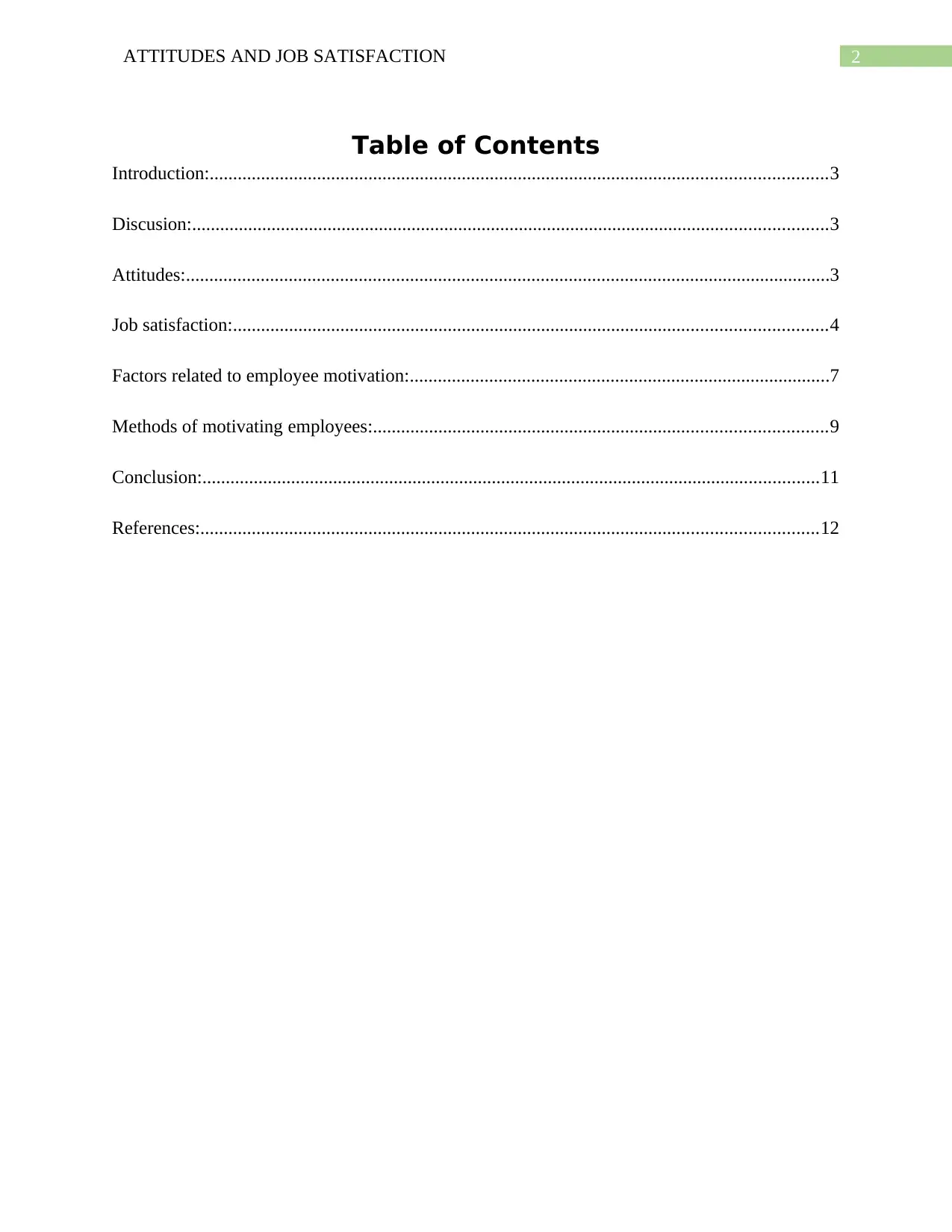
2ATTITUDES AND JOB SATISFACTION
Table of Contents
Introduction:....................................................................................................................................3
Discusion:........................................................................................................................................3
Attitudes:..........................................................................................................................................3
Job satisfaction:...............................................................................................................................4
Factors related to employee motivation:..........................................................................................7
Methods of motivating employees:.................................................................................................9
Conclusion:....................................................................................................................................11
References:....................................................................................................................................12
Table of Contents
Introduction:....................................................................................................................................3
Discusion:........................................................................................................................................3
Attitudes:..........................................................................................................................................3
Job satisfaction:...............................................................................................................................4
Factors related to employee motivation:..........................................................................................7
Methods of motivating employees:.................................................................................................9
Conclusion:....................................................................................................................................11
References:....................................................................................................................................12
⊘ This is a preview!⊘
Do you want full access?
Subscribe today to unlock all pages.

Trusted by 1+ million students worldwide
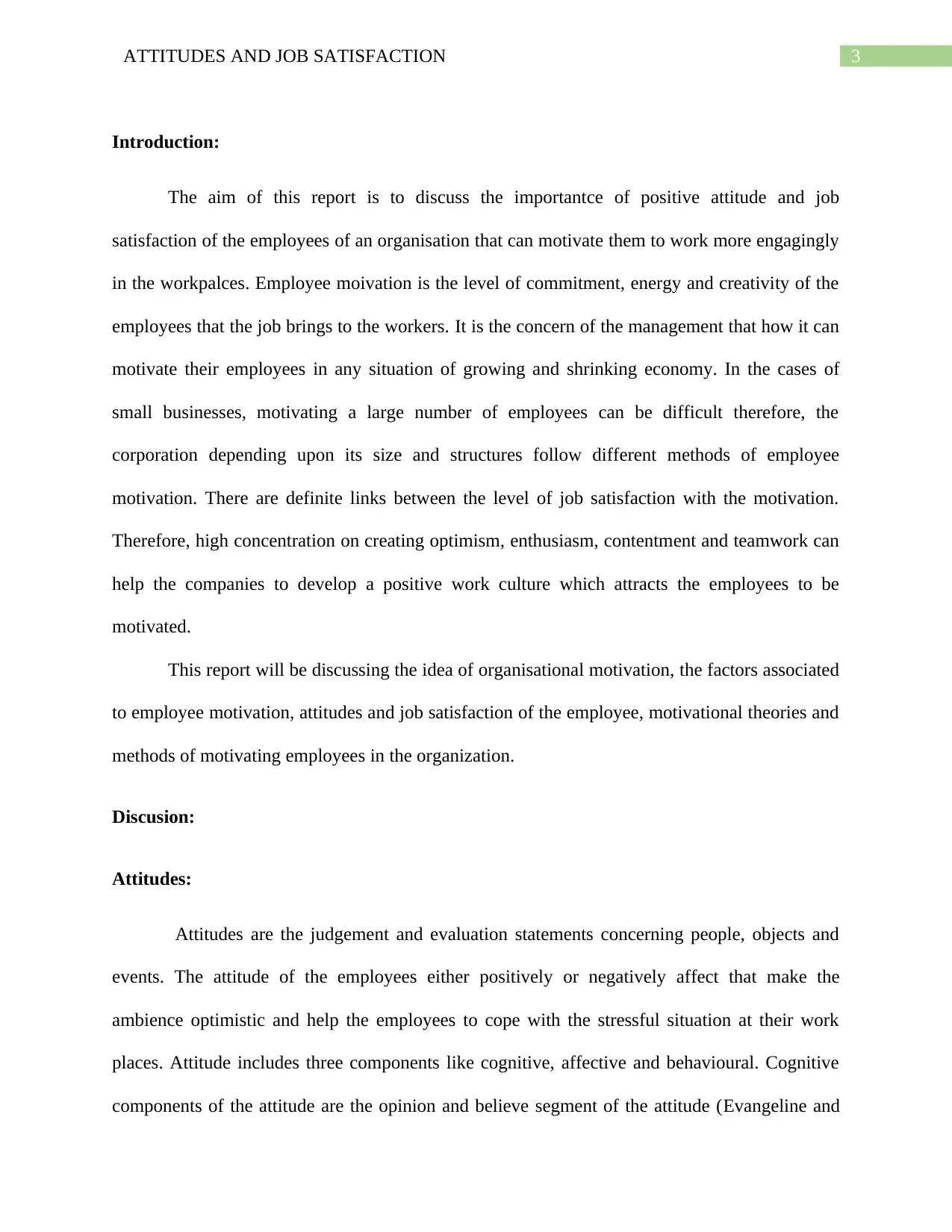
3ATTITUDES AND JOB SATISFACTION
Introduction:
The aim of this report is to discuss the importantce of positive attitude and job
satisfaction of the employees of an organisation that can motivate them to work more engagingly
in the workpalces. Employee moivation is the level of commitment, energy and creativity of the
employees that the job brings to the workers. It is the concern of the management that how it can
motivate their employees in any situation of growing and shrinking economy. In the cases of
small businesses, motivating a large number of employees can be difficult therefore, the
corporation depending upon its size and structures follow different methods of employee
motivation. There are definite links between the level of job satisfaction with the motivation.
Therefore, high concentration on creating optimism, enthusiasm, contentment and teamwork can
help the companies to develop a positive work culture which attracts the employees to be
motivated.
This report will be discussing the idea of organisational motivation, the factors associated
to employee motivation, attitudes and job satisfaction of the employee, motivational theories and
methods of motivating employees in the organization.
Discusion:
Attitudes:
Attitudes are the judgement and evaluation statements concerning people, objects and
events. The attitude of the employees either positively or negatively affect that make the
ambience optimistic and help the employees to cope with the stressful situation at their work
places. Attitude includes three components like cognitive, affective and behavioural. Cognitive
components of the attitude are the opinion and believe segment of the attitude (Evangeline and
Introduction:
The aim of this report is to discuss the importantce of positive attitude and job
satisfaction of the employees of an organisation that can motivate them to work more engagingly
in the workpalces. Employee moivation is the level of commitment, energy and creativity of the
employees that the job brings to the workers. It is the concern of the management that how it can
motivate their employees in any situation of growing and shrinking economy. In the cases of
small businesses, motivating a large number of employees can be difficult therefore, the
corporation depending upon its size and structures follow different methods of employee
motivation. There are definite links between the level of job satisfaction with the motivation.
Therefore, high concentration on creating optimism, enthusiasm, contentment and teamwork can
help the companies to develop a positive work culture which attracts the employees to be
motivated.
This report will be discussing the idea of organisational motivation, the factors associated
to employee motivation, attitudes and job satisfaction of the employee, motivational theories and
methods of motivating employees in the organization.
Discusion:
Attitudes:
Attitudes are the judgement and evaluation statements concerning people, objects and
events. The attitude of the employees either positively or negatively affect that make the
ambience optimistic and help the employees to cope with the stressful situation at their work
places. Attitude includes three components like cognitive, affective and behavioural. Cognitive
components of the attitude are the opinion and believe segment of the attitude (Evangeline and
Paraphrase This Document
Need a fresh take? Get an instant paraphrase of this document with our AI Paraphraser
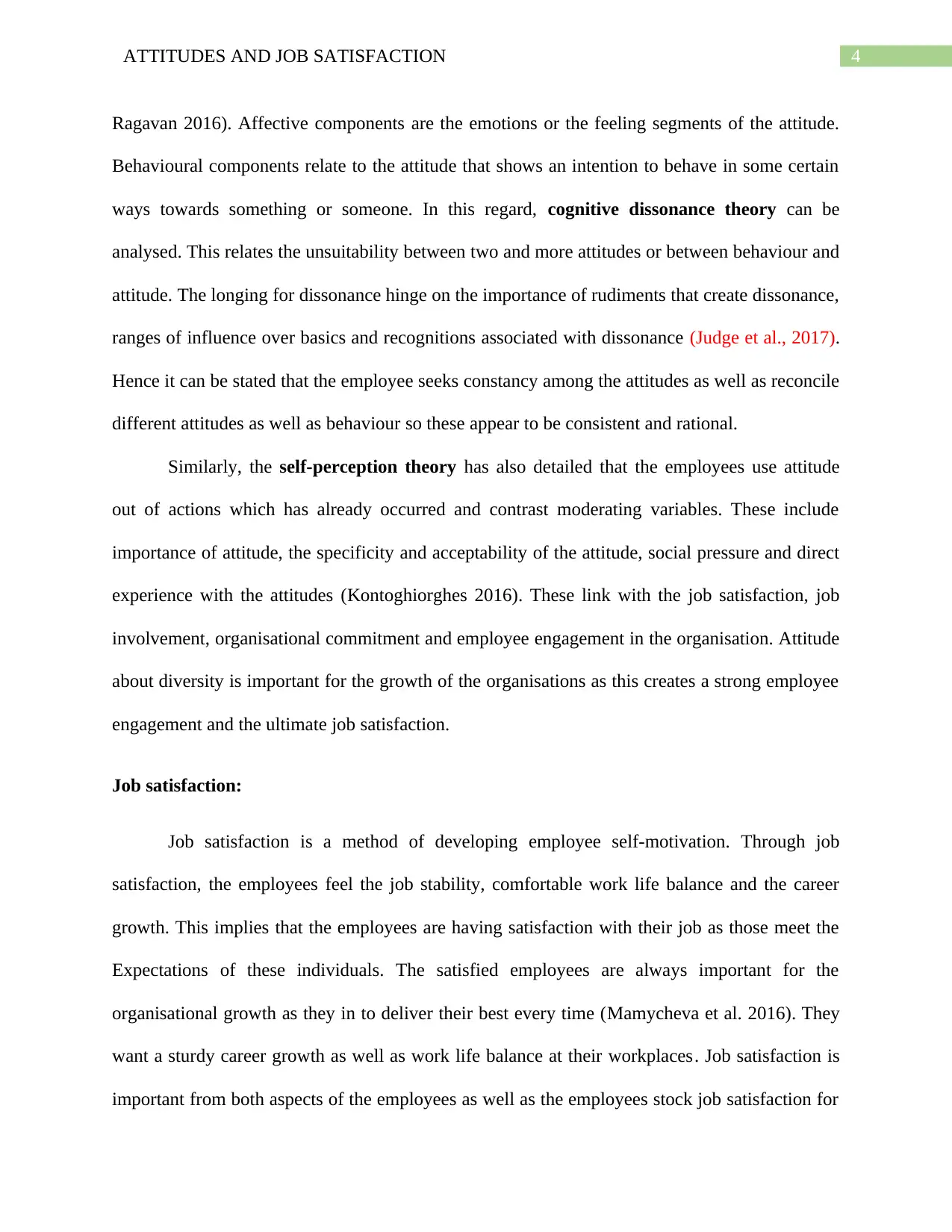
4ATTITUDES AND JOB SATISFACTION
Ragavan 2016). Affective components are the emotions or the feeling segments of the attitude.
Behavioural components relate to the attitude that shows an intention to behave in some certain
ways towards something or someone. In this regard, cognitive dissonance theory can be
analysed. This relates the unsuitability between two and more attitudes or between behaviour and
attitude. The longing for dissonance hinge on the importance of rudiments that create dissonance,
ranges of influence over basics and recognitions associated with dissonance (Judge et al., 2017).
Hence it can be stated that the employee seeks constancy among the attitudes as well as reconcile
different attitudes as well as behaviour so these appear to be consistent and rational.
Similarly, the self-perception theory has also detailed that the employees use attitude
out of actions which has already occurred and contrast moderating variables. These include
importance of attitude, the specificity and acceptability of the attitude, social pressure and direct
experience with the attitudes (Kontoghiorghes 2016). These link with the job satisfaction, job
involvement, organisational commitment and employee engagement in the organisation. Attitude
about diversity is important for the growth of the organisations as this creates a strong employee
engagement and the ultimate job satisfaction.
Job satisfaction:
Job satisfaction is a method of developing employee self-motivation. Through job
satisfaction, the employees feel the job stability, comfortable work life balance and the career
growth. This implies that the employees are having satisfaction with their job as those meet the
Expectations of these individuals. The satisfied employees are always important for the
organisational growth as they in to deliver their best every time (Mamycheva et al. 2016). They
want a sturdy career growth as well as work life balance at their workplaces. Job satisfaction is
important from both aspects of the employees as well as the employees stock job satisfaction for
Ragavan 2016). Affective components are the emotions or the feeling segments of the attitude.
Behavioural components relate to the attitude that shows an intention to behave in some certain
ways towards something or someone. In this regard, cognitive dissonance theory can be
analysed. This relates the unsuitability between two and more attitudes or between behaviour and
attitude. The longing for dissonance hinge on the importance of rudiments that create dissonance,
ranges of influence over basics and recognitions associated with dissonance (Judge et al., 2017).
Hence it can be stated that the employee seeks constancy among the attitudes as well as reconcile
different attitudes as well as behaviour so these appear to be consistent and rational.
Similarly, the self-perception theory has also detailed that the employees use attitude
out of actions which has already occurred and contrast moderating variables. These include
importance of attitude, the specificity and acceptability of the attitude, social pressure and direct
experience with the attitudes (Kontoghiorghes 2016). These link with the job satisfaction, job
involvement, organisational commitment and employee engagement in the organisation. Attitude
about diversity is important for the growth of the organisations as this creates a strong employee
engagement and the ultimate job satisfaction.
Job satisfaction:
Job satisfaction is a method of developing employee self-motivation. Through job
satisfaction, the employees feel the job stability, comfortable work life balance and the career
growth. This implies that the employees are having satisfaction with their job as those meet the
Expectations of these individuals. The satisfied employees are always important for the
organisational growth as they in to deliver their best every time (Mamycheva et al. 2016). They
want a sturdy career growth as well as work life balance at their workplaces. Job satisfaction is
important from both aspects of the employees as well as the employees stock job satisfaction for
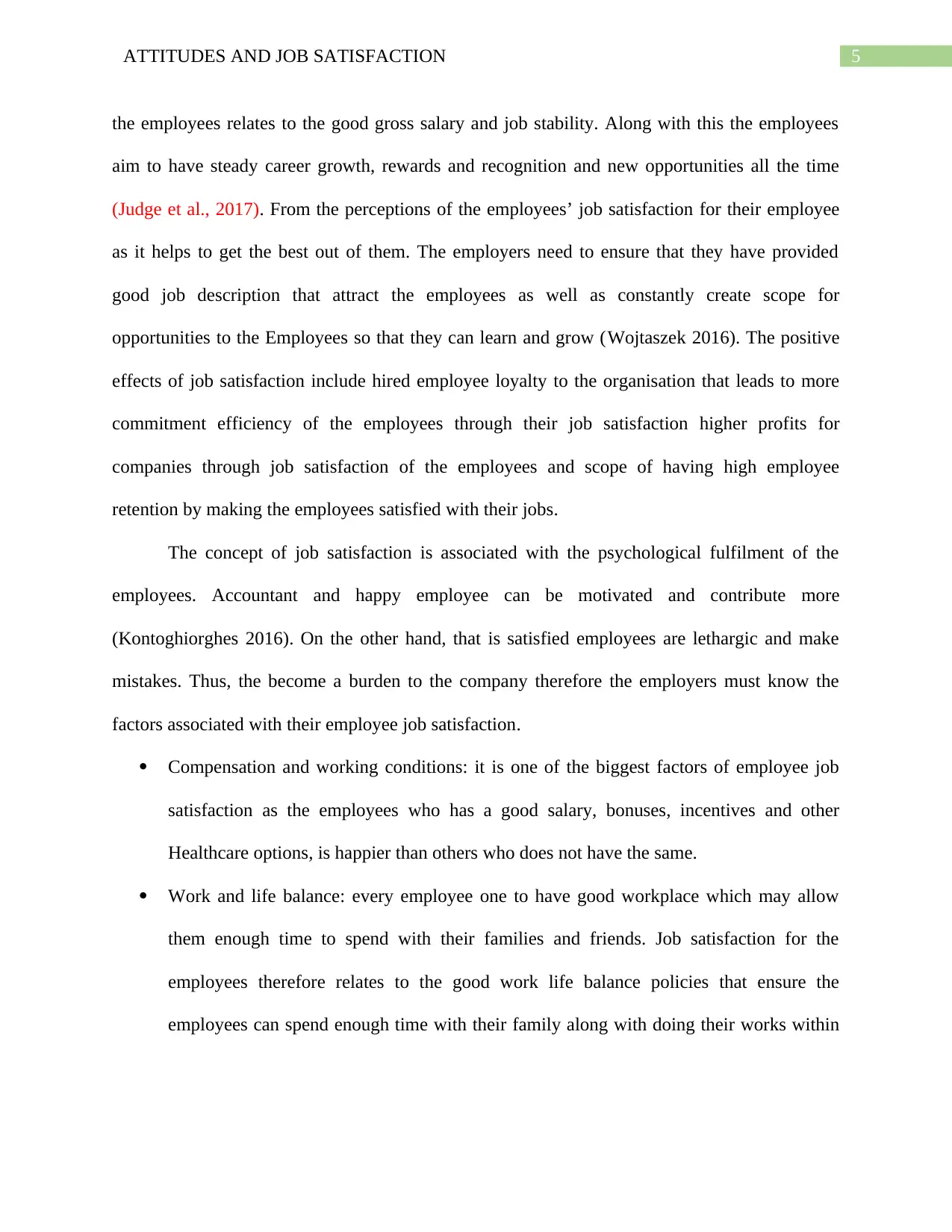
5ATTITUDES AND JOB SATISFACTION
the employees relates to the good gross salary and job stability. Along with this the employees
aim to have steady career growth, rewards and recognition and new opportunities all the time
(Judge et al., 2017). From the perceptions of the employees’ job satisfaction for their employee
as it helps to get the best out of them. The employers need to ensure that they have provided
good job description that attract the employees as well as constantly create scope for
opportunities to the Employees so that they can learn and grow (Wojtaszek 2016). The positive
effects of job satisfaction include hired employee loyalty to the organisation that leads to more
commitment efficiency of the employees through their job satisfaction higher profits for
companies through job satisfaction of the employees and scope of having high employee
retention by making the employees satisfied with their jobs.
The concept of job satisfaction is associated with the psychological fulfilment of the
employees. Accountant and happy employee can be motivated and contribute more
(Kontoghiorghes 2016). On the other hand, that is satisfied employees are lethargic and make
mistakes. Thus, the become a burden to the company therefore the employers must know the
factors associated with their employee job satisfaction.
Compensation and working conditions: it is one of the biggest factors of employee job
satisfaction as the employees who has a good salary, bonuses, incentives and other
Healthcare options, is happier than others who does not have the same.
Work and life balance: every employee one to have good workplace which may allow
them enough time to spend with their families and friends. Job satisfaction for the
employees therefore relates to the good work life balance policies that ensure the
employees can spend enough time with their family along with doing their works within
the employees relates to the good gross salary and job stability. Along with this the employees
aim to have steady career growth, rewards and recognition and new opportunities all the time
(Judge et al., 2017). From the perceptions of the employees’ job satisfaction for their employee
as it helps to get the best out of them. The employers need to ensure that they have provided
good job description that attract the employees as well as constantly create scope for
opportunities to the Employees so that they can learn and grow (Wojtaszek 2016). The positive
effects of job satisfaction include hired employee loyalty to the organisation that leads to more
commitment efficiency of the employees through their job satisfaction higher profits for
companies through job satisfaction of the employees and scope of having high employee
retention by making the employees satisfied with their jobs.
The concept of job satisfaction is associated with the psychological fulfilment of the
employees. Accountant and happy employee can be motivated and contribute more
(Kontoghiorghes 2016). On the other hand, that is satisfied employees are lethargic and make
mistakes. Thus, the become a burden to the company therefore the employers must know the
factors associated with their employee job satisfaction.
Compensation and working conditions: it is one of the biggest factors of employee job
satisfaction as the employees who has a good salary, bonuses, incentives and other
Healthcare options, is happier than others who does not have the same.
Work and life balance: every employee one to have good workplace which may allow
them enough time to spend with their families and friends. Job satisfaction for the
employees therefore relates to the good work life balance policies that ensure the
employees can spend enough time with their family along with doing their works within
⊘ This is a preview!⊘
Do you want full access?
Subscribe today to unlock all pages.

Trusted by 1+ million students worldwide
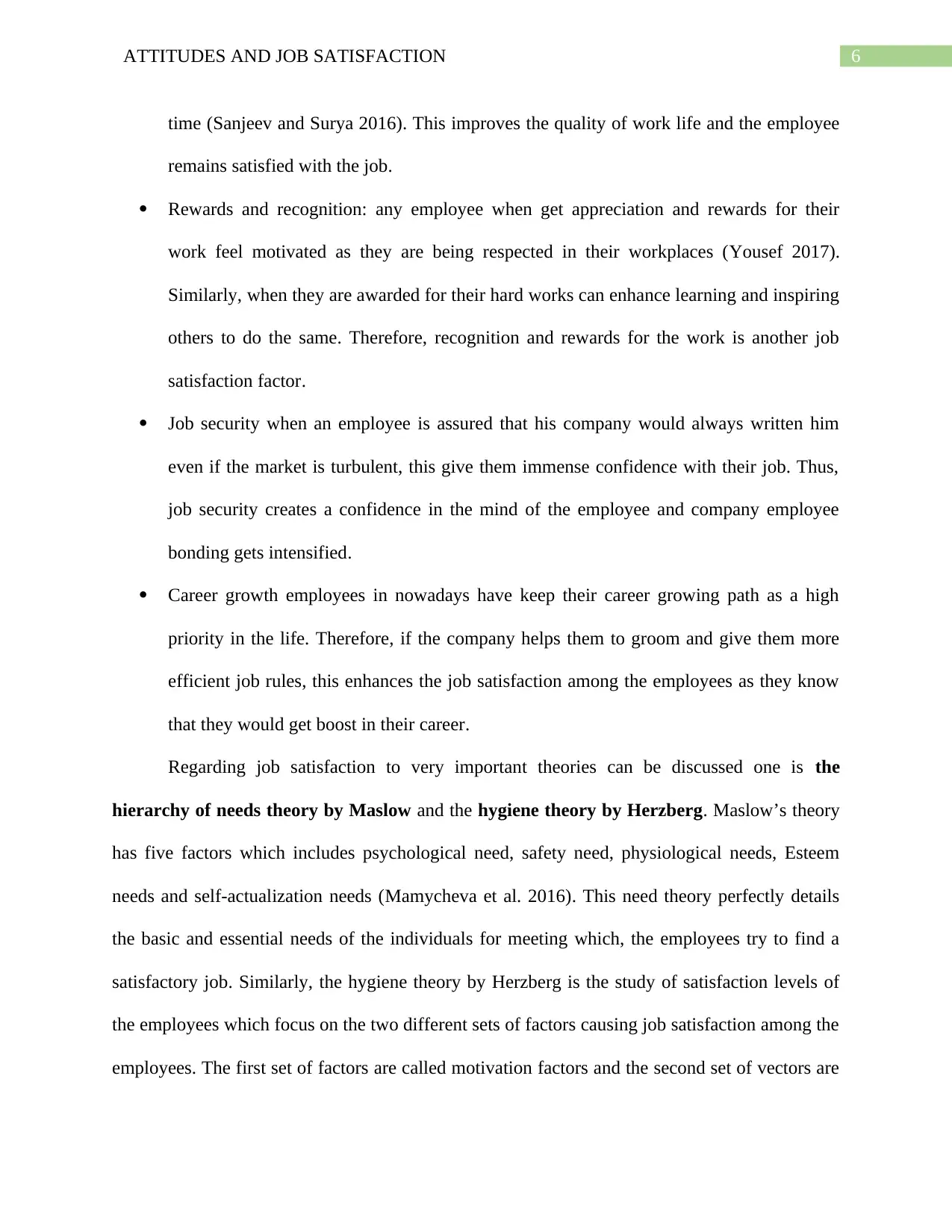
6ATTITUDES AND JOB SATISFACTION
time (Sanjeev and Surya 2016). This improves the quality of work life and the employee
remains satisfied with the job.
Rewards and recognition: any employee when get appreciation and rewards for their
work feel motivated as they are being respected in their workplaces (Yousef 2017).
Similarly, when they are awarded for their hard works can enhance learning and inspiring
others to do the same. Therefore, recognition and rewards for the work is another job
satisfaction factor.
Job security when an employee is assured that his company would always written him
even if the market is turbulent, this give them immense confidence with their job. Thus,
job security creates a confidence in the mind of the employee and company employee
bonding gets intensified.
Career growth employees in nowadays have keep their career growing path as a high
priority in the life. Therefore, if the company helps them to groom and give them more
efficient job rules, this enhances the job satisfaction among the employees as they know
that they would get boost in their career.
Regarding job satisfaction to very important theories can be discussed one is the
hierarchy of needs theory by Maslow and the hygiene theory by Herzberg. Maslow’s theory
has five factors which includes psychological need, safety need, physiological needs, Esteem
needs and self-actualization needs (Mamycheva et al. 2016). This need theory perfectly details
the basic and essential needs of the individuals for meeting which, the employees try to find a
satisfactory job. Similarly, the hygiene theory by Herzberg is the study of satisfaction levels of
the employees which focus on the two different sets of factors causing job satisfaction among the
employees. The first set of factors are called motivation factors and the second set of vectors are
time (Sanjeev and Surya 2016). This improves the quality of work life and the employee
remains satisfied with the job.
Rewards and recognition: any employee when get appreciation and rewards for their
work feel motivated as they are being respected in their workplaces (Yousef 2017).
Similarly, when they are awarded for their hard works can enhance learning and inspiring
others to do the same. Therefore, recognition and rewards for the work is another job
satisfaction factor.
Job security when an employee is assured that his company would always written him
even if the market is turbulent, this give them immense confidence with their job. Thus,
job security creates a confidence in the mind of the employee and company employee
bonding gets intensified.
Career growth employees in nowadays have keep their career growing path as a high
priority in the life. Therefore, if the company helps them to groom and give them more
efficient job rules, this enhances the job satisfaction among the employees as they know
that they would get boost in their career.
Regarding job satisfaction to very important theories can be discussed one is the
hierarchy of needs theory by Maslow and the hygiene theory by Herzberg. Maslow’s theory
has five factors which includes psychological need, safety need, physiological needs, Esteem
needs and self-actualization needs (Mamycheva et al. 2016). This need theory perfectly details
the basic and essential needs of the individuals for meeting which, the employees try to find a
satisfactory job. Similarly, the hygiene theory by Herzberg is the study of satisfaction levels of
the employees which focus on the two different sets of factors causing job satisfaction among the
employees. The first set of factors are called motivation factors and the second set of vectors are
Paraphrase This Document
Need a fresh take? Get an instant paraphrase of this document with our AI Paraphraser
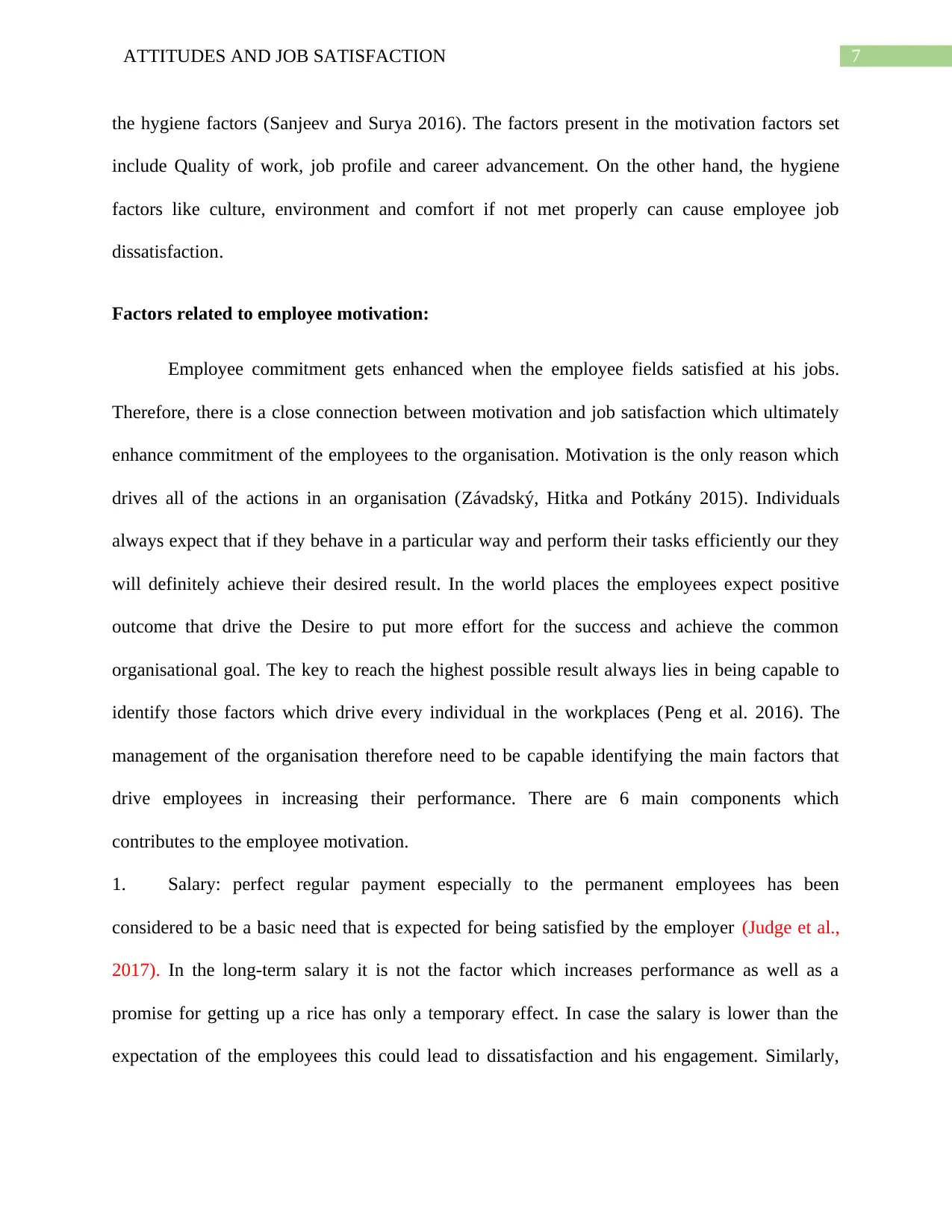
7ATTITUDES AND JOB SATISFACTION
the hygiene factors (Sanjeev and Surya 2016). The factors present in the motivation factors set
include Quality of work, job profile and career advancement. On the other hand, the hygiene
factors like culture, environment and comfort if not met properly can cause employee job
dissatisfaction.
Factors related to employee motivation:
Employee commitment gets enhanced when the employee fields satisfied at his jobs.
Therefore, there is a close connection between motivation and job satisfaction which ultimately
enhance commitment of the employees to the organisation. Motivation is the only reason which
drives all of the actions in an organisation (Závadský, Hitka and Potkány 2015). Individuals
always expect that if they behave in a particular way and perform their tasks efficiently our they
will definitely achieve their desired result. In the world places the employees expect positive
outcome that drive the Desire to put more effort for the success and achieve the common
organisational goal. The key to reach the highest possible result always lies in being capable to
identify those factors which drive every individual in the workplaces (Peng et al. 2016). The
management of the organisation therefore need to be capable identifying the main factors that
drive employees in increasing their performance. There are 6 main components which
contributes to the employee motivation.
1. Salary: perfect regular payment especially to the permanent employees has been
considered to be a basic need that is expected for being satisfied by the employer (Judge et al.,
2017). In the long-term salary it is not the factor which increases performance as well as a
promise for getting up a rice has only a temporary effect. In case the salary is lower than the
expectation of the employees this could lead to dissatisfaction and his engagement. Similarly,
the hygiene factors (Sanjeev and Surya 2016). The factors present in the motivation factors set
include Quality of work, job profile and career advancement. On the other hand, the hygiene
factors like culture, environment and comfort if not met properly can cause employee job
dissatisfaction.
Factors related to employee motivation:
Employee commitment gets enhanced when the employee fields satisfied at his jobs.
Therefore, there is a close connection between motivation and job satisfaction which ultimately
enhance commitment of the employees to the organisation. Motivation is the only reason which
drives all of the actions in an organisation (Závadský, Hitka and Potkány 2015). Individuals
always expect that if they behave in a particular way and perform their tasks efficiently our they
will definitely achieve their desired result. In the world places the employees expect positive
outcome that drive the Desire to put more effort for the success and achieve the common
organisational goal. The key to reach the highest possible result always lies in being capable to
identify those factors which drive every individual in the workplaces (Peng et al. 2016). The
management of the organisation therefore need to be capable identifying the main factors that
drive employees in increasing their performance. There are 6 main components which
contributes to the employee motivation.
1. Salary: perfect regular payment especially to the permanent employees has been
considered to be a basic need that is expected for being satisfied by the employer (Judge et al.,
2017). In the long-term salary it is not the factor which increases performance as well as a
promise for getting up a rice has only a temporary effect. In case the salary is lower than the
expectation of the employees this could lead to dissatisfaction and his engagement. Similarly,
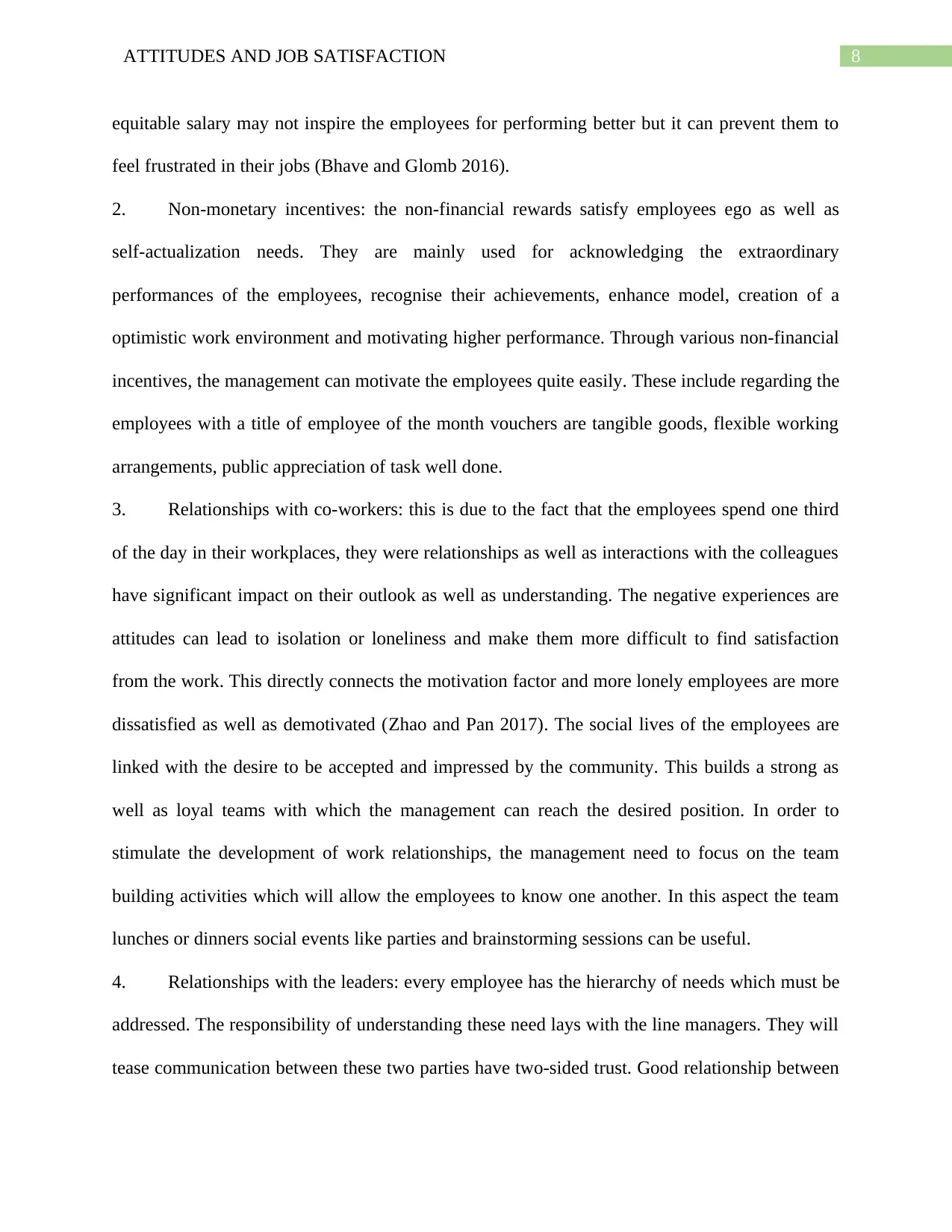
8ATTITUDES AND JOB SATISFACTION
equitable salary may not inspire the employees for performing better but it can prevent them to
feel frustrated in their jobs (Bhave and Glomb 2016).
2. Non-monetary incentives: the non-financial rewards satisfy employees ego as well as
self-actualization needs. They are mainly used for acknowledging the extraordinary
performances of the employees, recognise their achievements, enhance model, creation of a
optimistic work environment and motivating higher performance. Through various non-financial
incentives, the management can motivate the employees quite easily. These include regarding the
employees with a title of employee of the month vouchers are tangible goods, flexible working
arrangements, public appreciation of task well done.
3. Relationships with co-workers: this is due to the fact that the employees spend one third
of the day in their workplaces, they were relationships as well as interactions with the colleagues
have significant impact on their outlook as well as understanding. The negative experiences are
attitudes can lead to isolation or loneliness and make them more difficult to find satisfaction
from the work. This directly connects the motivation factor and more lonely employees are more
dissatisfied as well as demotivated (Zhao and Pan 2017). The social lives of the employees are
linked with the desire to be accepted and impressed by the community. This builds a strong as
well as loyal teams with which the management can reach the desired position. In order to
stimulate the development of work relationships, the management need to focus on the team
building activities which will allow the employees to know one another. In this aspect the team
lunches or dinners social events like parties and brainstorming sessions can be useful.
4. Relationships with the leaders: every employee has the hierarchy of needs which must be
addressed. The responsibility of understanding these need lays with the line managers. They will
tease communication between these two parties have two-sided trust. Good relationship between
equitable salary may not inspire the employees for performing better but it can prevent them to
feel frustrated in their jobs (Bhave and Glomb 2016).
2. Non-monetary incentives: the non-financial rewards satisfy employees ego as well as
self-actualization needs. They are mainly used for acknowledging the extraordinary
performances of the employees, recognise their achievements, enhance model, creation of a
optimistic work environment and motivating higher performance. Through various non-financial
incentives, the management can motivate the employees quite easily. These include regarding the
employees with a title of employee of the month vouchers are tangible goods, flexible working
arrangements, public appreciation of task well done.
3. Relationships with co-workers: this is due to the fact that the employees spend one third
of the day in their workplaces, they were relationships as well as interactions with the colleagues
have significant impact on their outlook as well as understanding. The negative experiences are
attitudes can lead to isolation or loneliness and make them more difficult to find satisfaction
from the work. This directly connects the motivation factor and more lonely employees are more
dissatisfied as well as demotivated (Zhao and Pan 2017). The social lives of the employees are
linked with the desire to be accepted and impressed by the community. This builds a strong as
well as loyal teams with which the management can reach the desired position. In order to
stimulate the development of work relationships, the management need to focus on the team
building activities which will allow the employees to know one another. In this aspect the team
lunches or dinners social events like parties and brainstorming sessions can be useful.
4. Relationships with the leaders: every employee has the hierarchy of needs which must be
addressed. The responsibility of understanding these need lays with the line managers. They will
tease communication between these two parties have two-sided trust. Good relationship between
⊘ This is a preview!⊘
Do you want full access?
Subscribe today to unlock all pages.

Trusted by 1+ million students worldwide
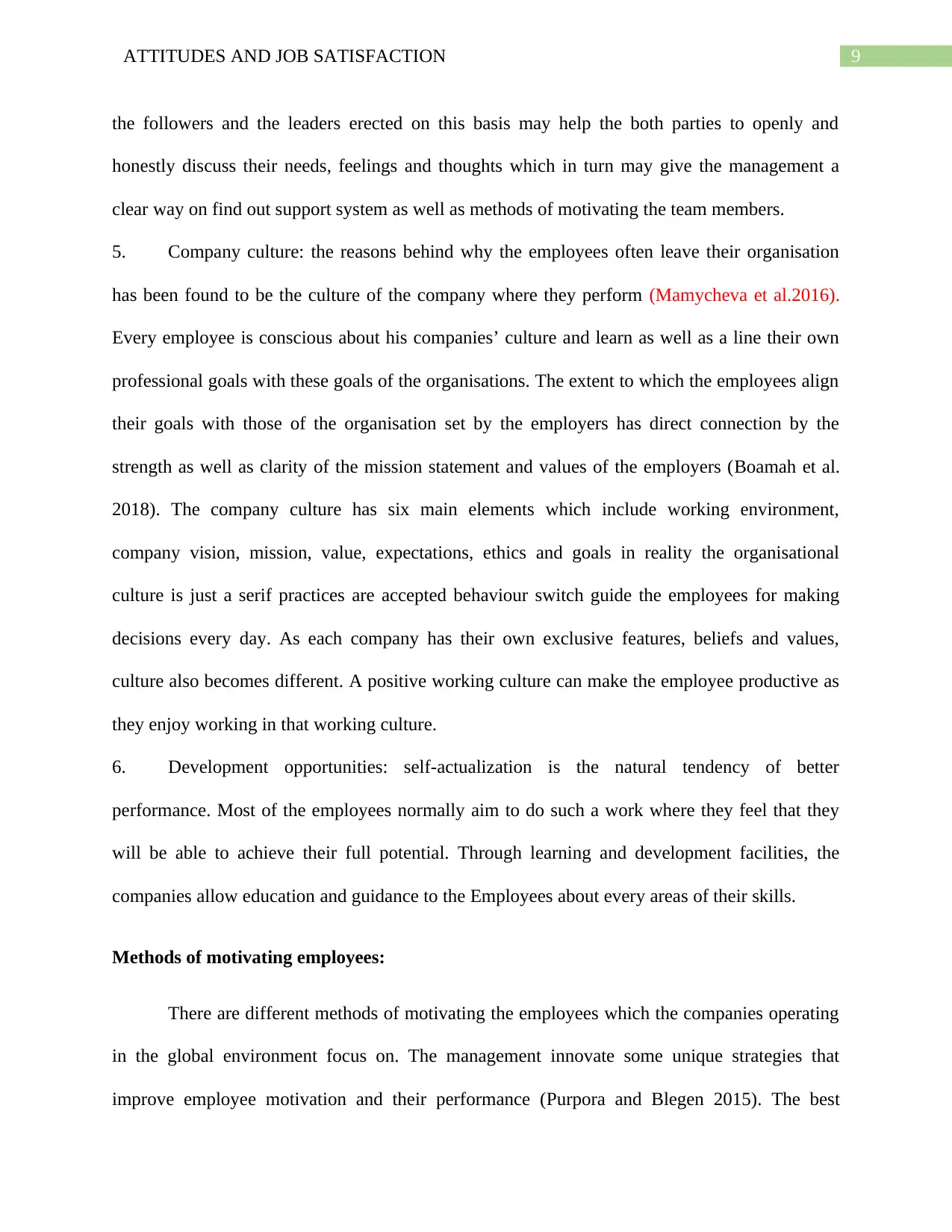
9ATTITUDES AND JOB SATISFACTION
the followers and the leaders erected on this basis may help the both parties to openly and
honestly discuss their needs, feelings and thoughts which in turn may give the management a
clear way on find out support system as well as methods of motivating the team members.
5. Company culture: the reasons behind why the employees often leave their organisation
has been found to be the culture of the company where they perform (Mamycheva et al.2016).
Every employee is conscious about his companies’ culture and learn as well as a line their own
professional goals with these goals of the organisations. The extent to which the employees align
their goals with those of the organisation set by the employers has direct connection by the
strength as well as clarity of the mission statement and values of the employers (Boamah et al.
2018). The company culture has six main elements which include working environment,
company vision, mission, value, expectations, ethics and goals in reality the organisational
culture is just a serif practices are accepted behaviour switch guide the employees for making
decisions every day. As each company has their own exclusive features, beliefs and values,
culture also becomes different. A positive working culture can make the employee productive as
they enjoy working in that working culture.
6. Development opportunities: self-actualization is the natural tendency of better
performance. Most of the employees normally aim to do such a work where they feel that they
will be able to achieve their full potential. Through learning and development facilities, the
companies allow education and guidance to the Employees about every areas of their skills.
Methods of motivating employees:
There are different methods of motivating the employees which the companies operating
in the global environment focus on. The management innovate some unique strategies that
improve employee motivation and their performance (Purpora and Blegen 2015). The best
the followers and the leaders erected on this basis may help the both parties to openly and
honestly discuss their needs, feelings and thoughts which in turn may give the management a
clear way on find out support system as well as methods of motivating the team members.
5. Company culture: the reasons behind why the employees often leave their organisation
has been found to be the culture of the company where they perform (Mamycheva et al.2016).
Every employee is conscious about his companies’ culture and learn as well as a line their own
professional goals with these goals of the organisations. The extent to which the employees align
their goals with those of the organisation set by the employers has direct connection by the
strength as well as clarity of the mission statement and values of the employers (Boamah et al.
2018). The company culture has six main elements which include working environment,
company vision, mission, value, expectations, ethics and goals in reality the organisational
culture is just a serif practices are accepted behaviour switch guide the employees for making
decisions every day. As each company has their own exclusive features, beliefs and values,
culture also becomes different. A positive working culture can make the employee productive as
they enjoy working in that working culture.
6. Development opportunities: self-actualization is the natural tendency of better
performance. Most of the employees normally aim to do such a work where they feel that they
will be able to achieve their full potential. Through learning and development facilities, the
companies allow education and guidance to the Employees about every areas of their skills.
Methods of motivating employees:
There are different methods of motivating the employees which the companies operating
in the global environment focus on. The management innovate some unique strategies that
improve employee motivation and their performance (Purpora and Blegen 2015). The best
Paraphrase This Document
Need a fresh take? Get an instant paraphrase of this document with our AI Paraphraser
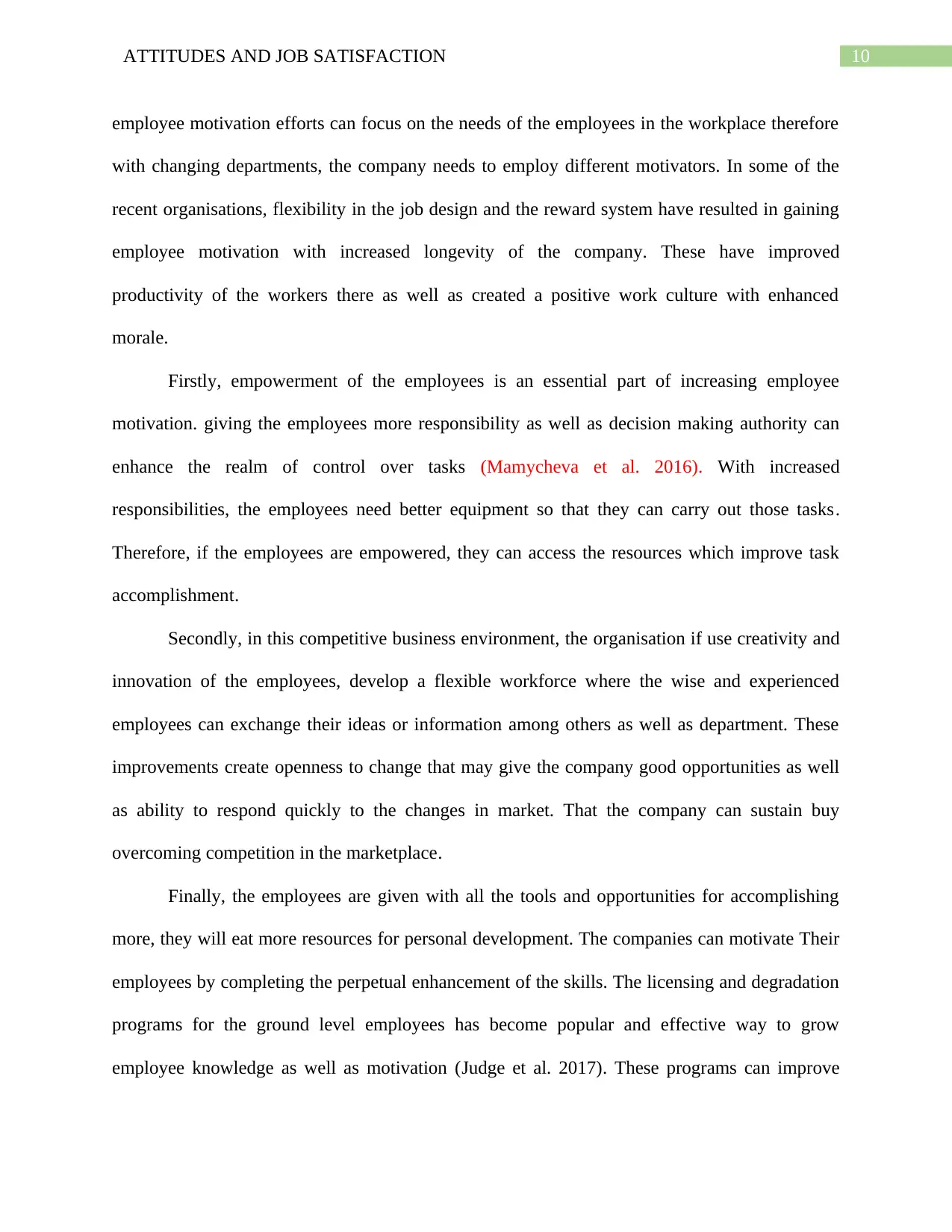
10ATTITUDES AND JOB SATISFACTION
employee motivation efforts can focus on the needs of the employees in the workplace therefore
with changing departments, the company needs to employ different motivators. In some of the
recent organisations, flexibility in the job design and the reward system have resulted in gaining
employee motivation with increased longevity of the company. These have improved
productivity of the workers there as well as created a positive work culture with enhanced
morale.
Firstly, empowerment of the employees is an essential part of increasing employee
motivation. giving the employees more responsibility as well as decision making authority can
enhance the realm of control over tasks (Mamycheva et al. 2016). With increased
responsibilities, the employees need better equipment so that they can carry out those tasks.
Therefore, if the employees are empowered, they can access the resources which improve task
accomplishment.
Secondly, in this competitive business environment, the organisation if use creativity and
innovation of the employees, develop a flexible workforce where the wise and experienced
employees can exchange their ideas or information among others as well as department. These
improvements create openness to change that may give the company good opportunities as well
as ability to respond quickly to the changes in market. That the company can sustain buy
overcoming competition in the marketplace.
Finally, the employees are given with all the tools and opportunities for accomplishing
more, they will eat more resources for personal development. The companies can motivate Their
employees by completing the perpetual enhancement of the skills. The licensing and degradation
programs for the ground level employees has become popular and effective way to grow
employee knowledge as well as motivation (Judge et al. 2017). These programs can improve
employee motivation efforts can focus on the needs of the employees in the workplace therefore
with changing departments, the company needs to employ different motivators. In some of the
recent organisations, flexibility in the job design and the reward system have resulted in gaining
employee motivation with increased longevity of the company. These have improved
productivity of the workers there as well as created a positive work culture with enhanced
morale.
Firstly, empowerment of the employees is an essential part of increasing employee
motivation. giving the employees more responsibility as well as decision making authority can
enhance the realm of control over tasks (Mamycheva et al. 2016). With increased
responsibilities, the employees need better equipment so that they can carry out those tasks.
Therefore, if the employees are empowered, they can access the resources which improve task
accomplishment.
Secondly, in this competitive business environment, the organisation if use creativity and
innovation of the employees, develop a flexible workforce where the wise and experienced
employees can exchange their ideas or information among others as well as department. These
improvements create openness to change that may give the company good opportunities as well
as ability to respond quickly to the changes in market. That the company can sustain buy
overcoming competition in the marketplace.
Finally, the employees are given with all the tools and opportunities for accomplishing
more, they will eat more resources for personal development. The companies can motivate Their
employees by completing the perpetual enhancement of the skills. The licensing and degradation
programs for the ground level employees has become popular and effective way to grow
employee knowledge as well as motivation (Judge et al. 2017). These programs can improve
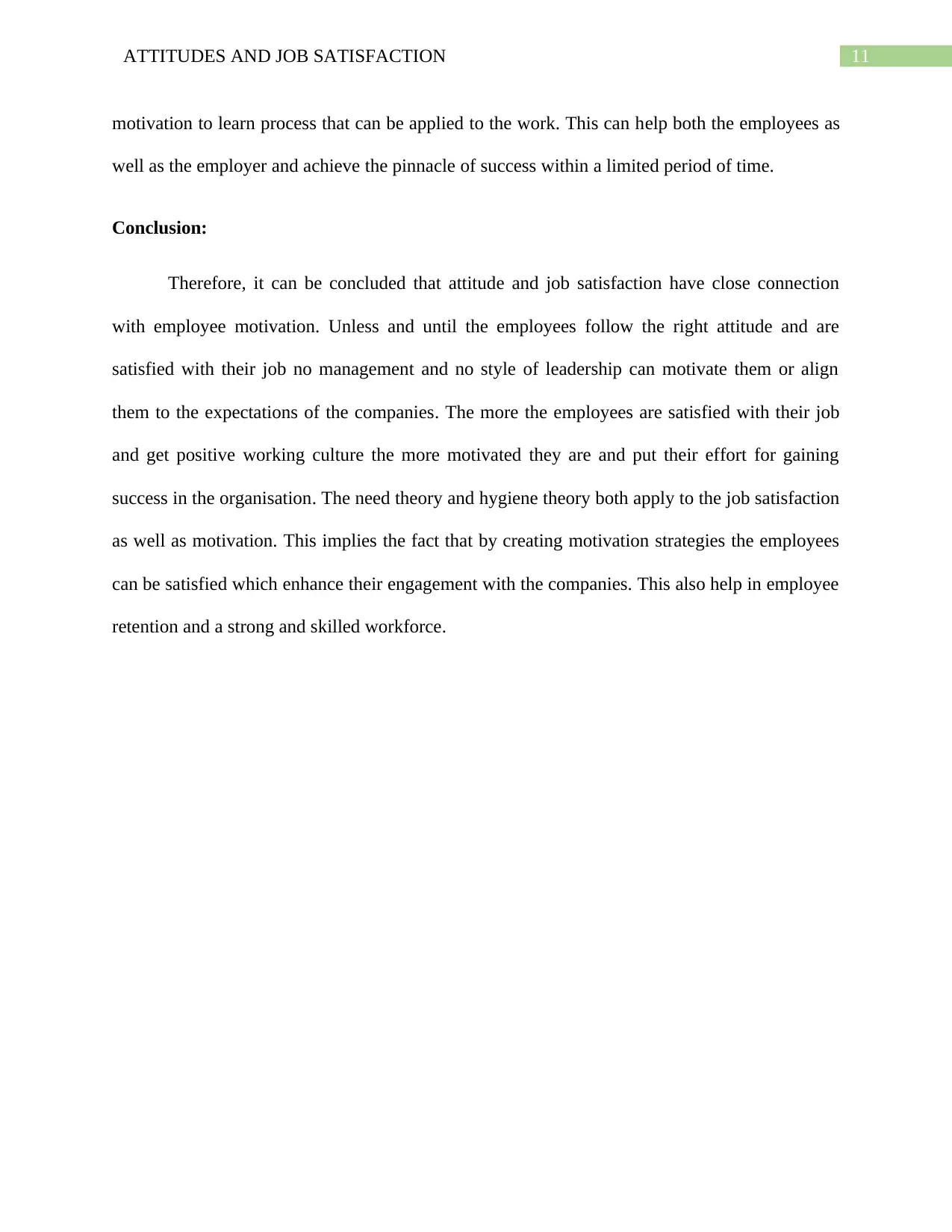
11ATTITUDES AND JOB SATISFACTION
motivation to learn process that can be applied to the work. This can help both the employees as
well as the employer and achieve the pinnacle of success within a limited period of time.
Conclusion:
Therefore, it can be concluded that attitude and job satisfaction have close connection
with employee motivation. Unless and until the employees follow the right attitude and are
satisfied with their job no management and no style of leadership can motivate them or align
them to the expectations of the companies. The more the employees are satisfied with their job
and get positive working culture the more motivated they are and put their effort for gaining
success in the organisation. The need theory and hygiene theory both apply to the job satisfaction
as well as motivation. This implies the fact that by creating motivation strategies the employees
can be satisfied which enhance their engagement with the companies. This also help in employee
retention and a strong and skilled workforce.
motivation to learn process that can be applied to the work. This can help both the employees as
well as the employer and achieve the pinnacle of success within a limited period of time.
Conclusion:
Therefore, it can be concluded that attitude and job satisfaction have close connection
with employee motivation. Unless and until the employees follow the right attitude and are
satisfied with their job no management and no style of leadership can motivate them or align
them to the expectations of the companies. The more the employees are satisfied with their job
and get positive working culture the more motivated they are and put their effort for gaining
success in the organisation. The need theory and hygiene theory both apply to the job satisfaction
as well as motivation. This implies the fact that by creating motivation strategies the employees
can be satisfied which enhance their engagement with the companies. This also help in employee
retention and a strong and skilled workforce.
⊘ This is a preview!⊘
Do you want full access?
Subscribe today to unlock all pages.

Trusted by 1+ million students worldwide
1 out of 14
Related Documents
Your All-in-One AI-Powered Toolkit for Academic Success.
+13062052269
info@desklib.com
Available 24*7 on WhatsApp / Email
![[object Object]](/_next/static/media/star-bottom.7253800d.svg)
Unlock your academic potential
Copyright © 2020–2025 A2Z Services. All Rights Reserved. Developed and managed by ZUCOL.





